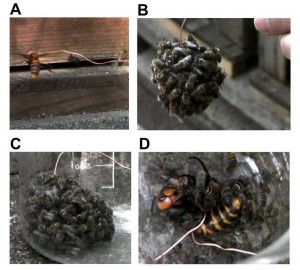Brain activity of Japanese honeybees forming a ‘hot defensive bee ball’ Is temperature information processing involved?

When a giant hornet enters a Japanese honeybee hive, hundreds of worker honeybees quickly surround the hornet to form a ‘hot defensive bee ball’, killing the hornet inside the ball with heat. Because European honeybees do not exhibit this behavior, the bee ball formation is considered to have evolved specifically in Japanese honeybees to avoid predation by the giant hornets that inhabit in East Asia. However, the neural activity regulating bee-ball formation remains unknown.

Fig. 1. Artificial bee ball formation: The hot defensive bee ball is usually formed in the beehive. To collect only the workers involved in forming the bee ball, we inserted a giant hornet suspended on the tip of a wire into a hive (A) to allow the Japanese honeybees form a bee ball around the giant hornet (B), and recovered the bee ball in a glass beaker (C). The decoy hornet inside the bee ball was dead 60 min after formation of the bee ball (D).
Graduate student Atsushi Ugajin and a team at the Department of Biological Sciences, Graduate School of Science first used a neural activity marker gene to show that a subpopulation of neurons that comprise the mushroom bodies (a higher brain center) is active in the brains of Japanese honeybee workers forming a bee ball. Similar neural activity was also observed in the brains of workers merely exposed to high temperature, suggesting that high temperature information is processed in the brains of workers that form a bee ball.
The neural activity detected might be related to monitoring the temperature inside the bee ball. Comparison of neural activity between the European and Japanese honeybees may help to clarify the neural basis of hot defensive bee-ball formation, which only Japanese honeybees have acquired during their species evolution. This study was performed in collaboration with researchers in Kanazawa University and Tamagawa University.
Atsushi Ugajin, Taketoshi Kiya, Takekazu Kunieda, Masato Ono, Tadaharu Yoshida, Takeo Kubo,
“Detection of neural activity in the brains of Japanese honeybee workers during the formation of a ‘Hot Defensive Bee Ball’”,
PLoS ONE 7(3): e32902. doi:10.1371/journal.pone.0032902
Article link






